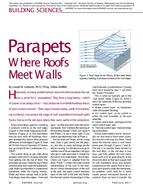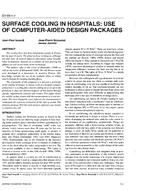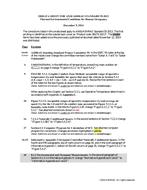Click here to purchase
Long-term care facilities (LTCs) have been among the Canadian institutions hit hardest by the COVID-19 pandemic. While it is well established that indoor air quality (IAQ) affects the health outcomes of building occupants, the role of IAQ in combating the current pandemic remains an emerging research area, especially with regards to vulnerable populations such as senior citizens. This paper examines heating, ventilating, and air-conditioning (HVAC) strategies for reducing the spread of the SARS-CoV-2 virus in Canadian LTCs. To study the effect of different HVAC strategies on disease transmission, a representative single-story LTC was designed based on real-world examples. This representative model was designed using a commercial building information modelling software (BIM) and a commercial and freely available building energy modelling software (BEM). The spread of airborne particles – and, consequently, pathogens – was simulated using FaTIMA (Fate and Transport of Indoor Microbiological Aerosols), a free software created by the American National Institute of Standards and Technology (NIST). The reference design was then iteratively improved to create a final design which incorporated HVAC strategies that reduced the concentration of airborne particles. For the final design, total building airflow was increased from 6286 m3/hr (3700 CFM) to 8325 m3/hr (4900 CFM) and air filters were upgraded from MERV 8 to MERV 13 or equivalent. Room air cleaners were introduced to problem areas and room occupancy was limited where necessary. Cumulatively, these measures led to significant reductions in the concentration of aerosolized particles throughout the facility. Small, shared spaces benefitted the most from the measures; the office showed the greatest improvement, with a 99.9% reduction in airborne particle concentration due primarily to a decrease in the number of occupants (one-at-a-time rule). Due to their larger size and high occupancy, spaces such as the main hallway or the lounge saw far lower improvements compared to smaller shared spaces. The smallest improvement in concentration was seen in the hallway, which experienced a 30% improvement in airborne particle concentration. These COVID-mitigating HVAC strategies were introduced with only a modest increase in annual building natural gas usage for space heating, which rose 7.70% from 85 MWh (290 MMBtu) to 91 MWh (312 MMBtu) due to the increased ventilation.
Product Details
- Published:
- 2022
- Number of Pages:
- 8
- Units of Measure:
- Dual
- File Size:
- 1 file , 4.9 MB
- Product Code(s):
- D-TO-22-C005
- Note:
- This product is unavailable in Russia, Belarus


